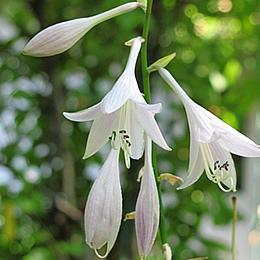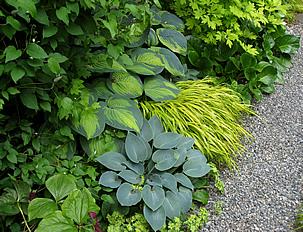The hosta is a herbaceous, rhizomatous plant with ornamental foliage, native to China, Korea, and Japan. It has gained popularity in temperate climates and is a constant presence at major fairs and annual exhibitions. The genus Hosta comprises 45 different species, along with numerous hybrids and cultivars, totaling over 2,500 options. The vast majority of these are used for ornamental purposes and eagerly sought after by avid collectors.

It features oval to lanceolate, leathery leaves that are highly attractive, appearing either glossy or matte, with prominent veins. The size, colors, and patterns of the leaves vary depending on the species and variety. Hostas exhibit a wide range of green shades, from lemon yellow to dark green, including blue, white, and yellow.
Some cultivars may undergo seasonal changes in leaf color, transitioning from green to yellow and other variations, influenced by lighting conditions. In addition to their beautiful foliage, hostas bloom in the summer, producing panicle-type inflorescences that rise above the foliage. These inflorescences consist of numerous trumpet-shaped flowers, either single or double, delicately scented, and available in white, pink, lilac, or blue hues.

Hostas excel as ground covers, with their compact form and colorful foliage suitable for mass plantings and borders in partial shade. Experiment by combining different hosta cultivars for an interesting effect.
Plants with diverse sizes and colors, but with the same texture and form pattern, provide unity and coherence without becoming monotonous. They also serve as ideal backdrops for perennial or annual flowers. Hostas tend to cover the ground well, suppressing weed growth. They can also be planted in pots and containers for foliage interest.
Cultivate hostas in fertile, well-draining, slightly acidic soil enriched with organic matter, and keep it consistently moist. Despite the somewhat tropical appearance with large and colorful leaves, hostas are plants suited for temperate to subtropical climates. They prefer mild temperatures and are averse to excessive heat, especially if it’s dry. Consequently, they thrive best in the southern regions of the country and in locations with tropical high-altitude climates.
After the first frost, hostas yellow and dry their leaves, entering a dormant phase that requires a clean pruning to improve their appearance. In spring, they vigorously regrow. Plant them in areas protected from strong winds, which can damage and desiccate their leaves. Hostas have a high water demand during their growth period, but once well-established with a good layer of mulch over the soil, they can tolerate short periods of drought. They are susceptible to slug and snail attacks. Replant every 2 or 3 years and propagate through clump division in early spring.


